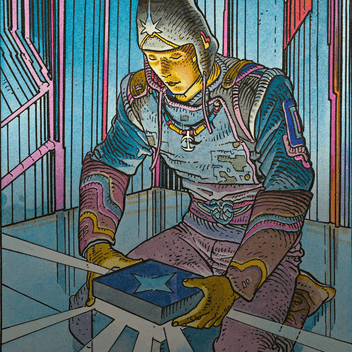Exhibition
Bande dessinée, 1964 - 2024

Artistic issues
When the Centre Pompidou partnered with Ircam, considered commissioning a musical environment for a gallery in the "Comics (1964-2024)" exhibition (May 29-November 24, 2024), the name of Sébastien Gaxie was quickly drawn to the fore. His eclectic personality and inspirations (literature, dance, cinema, animation, and even gourmet cuisine), the variety of his fields of expression (contemporary, jazz, electronic, musical theater, literature, video art...) and his sound research on the bangs of the current scene make him an ideal candidate. What's more, one of his recent projects, Auctus Animalis, which won the Swiss Life Prize, includes a sonic installation.
Second principle: vocal highlighting of the main characters. When speaking, the voice rarely stays on a single note. On the contrary: each phoneme is said on a particular note, and the melodic curve depends on the expressive content of the phrase (joy, sadness, anguish, etc.). Although this technique was not invented by Sébastien Gaxie, it has become part of his toolbox as a generator of material and expressiveness. In this case, he had actors read the texts in the speech bubbles - sometimes using the language of the original version to vary the sounds - directing them in the manner of a stage director (including shouting and whispering). Picking out these "melodies", he orchestrated them using instrumental synthesis or, in certain situations, real instruments, said orchestration naturally reflecting the character of each character - as with the marimba for Pinocchio...
The third and final principle is to establish a narrative. For each panel, Gaxie adheres to the sequence of the illustrated frames, with the trajectory of the sound accompanying that of the reader's eye. It's up to the viewer to imagine his or her own film.
"I'm juggling different ways of dividing up the space, between polyphonic passages where all the comics are mixed together, and focusing on successive panels. The relationship to space has to be continually reinvented."
"Another exciting aspect of the exercise is that, as the four comics are set in distinct historical periods, they allow us to explore different musical styles. For example, the score for Of Mice and Men is reminiscent of Prokofiev's theatrical writing of the era, which fascinated me when I reread Steinbeck as interpreted by Dautremer. As for Vernon Subutex, I opted for a very 80s synthesis, very electro, accompanied by vinyl noises that reflect the atmosphere of the selected passage. In her book, Despentes makes one musical reference after another, her way of describing the emotional trajectory of her character. I wanted to give her the gift of setting to music what she had imagined - by sticking to her references."
Technological issues
"I've rarely had good experiences with museum sound," says Sébastien Gaxie.
"I often find it either irrelevant or too intrusive. For this exhibition, I want the sound to be immediately associated with the image. In addition to the computer environment and the sound diffusion system (with a loudspeaker above each photo) that we had developed with Manuel Poletti, the experience of Auctus Animalis taught me that you need to renew the sounds broadcast quite frequently, but also that the trajectories of visitors through the museum space can be suggested by the localization of sound. This has to be the guiding principle when thinking about the sound organization of the space."
The very nature of an exhibition space comes with its own set of constraints. Starting with traffic flow issues: it would be unthinkable to clog up the space by letting visitors crowd in front of a single display panel!
Another idea taken from the Auctus Animalis experience is the principle of a referent sound that allows the user to recognize the sound identity of a comic in a matter of seconds. These sounds - which are reminiscent of cinematic background sounds and sound effects - are deduced from the plates on display: as the scene chosen for Of mice and men takes place in a stable, the sounds of a horse were the obvious choice. For Brouillard au pont Tolbiac, it's a subway atmosphere, while Vernon Subutex is immersed in the hum of the city night.
"These reference sounds allow me to divide up the space, to invite you to wander around, but also to create focal points for your attention, so that you can enter the specific worlds of each of the four comics in turn. The rest of the time, the discourse must circulate more rapidly, allowing the micro and the macro to coexist. But in the end, it's child's play."
By Jérémie Szpirglas